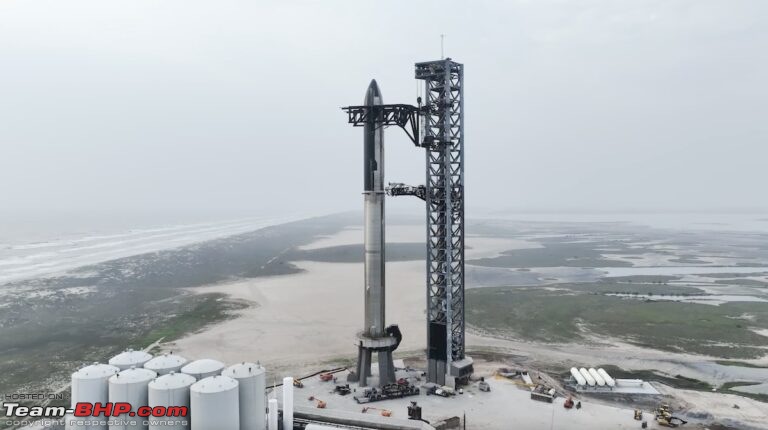SpaceX Starship
Background
Starship is Elon Musk’s big project to develop a reusable moon rocket that can carry a useful payload of a staggering 150 tonnes. It is a super heavy-lift launch vehicle under development by SpaceX. Standing at 119 m (390 ft) tall, it is the tallest and most powerful launch vehicle ever built, and the first intended to be fully reusable. The Starship will be more powerful than the Saturn V rockets that powered the Apollo missions to the moon half a century ago.
The original launch was scheduled for 17th April. A technical snag has postponed the launch to 20th April. If Elon Musk, for all his faults succeeds it will be a mind blowing achievement given that this is not being funded by the tax payer. And this is a real space project as opposed to those recent ego massage sub-orbital flights by Branson & Bezos.
https://www.firstpost.com/explainers...-12467692.html
The closest comparable rocket in terms of power and payload was the Apollo mission's Saturn V {called Saturn Five} which cost US$1.23 billion per rocket. Elon Musk claims his rocket will on mass production & use cost $2 million per launch.

The two stages when first mated
The Starship
The Starship launch vehicle is made up of the first-stage named Super Heavy booster and the Starship proper as a second stage. The second stage functions as a self-contained spacecraft for carrying crew or cargo once in orbit. Both rocket stages are powered by Raptor engines, which burn liquid oxygen and liquid methane propellants in a highly efficient full-flow staged combustion cycle. After completing their flight, both rocket stages will be recovered separately, including the Super Heavy booster which would be caught by the launch tower's mechanical arms!

The second stage or the Starship proper that carries the payload. The small wing surfaces are to provide control while landing back and within the atmosphere.
Starship is planned to have a payload capacity of 150 tonne to low Earth orbit in its fully reusable configuration and 250 tonnes to low Earth orbit if fully expended. It is designed to be flown multiple times to spread out the cost of the spacecraft. The spacecraft is planned to be refuelable in orbit before traveling to destinations that require more change in velocity to reach them, such as the Moon and Mars. Proposed near-term applications for Starship include delivering astronauts and large satellites to Earth orbit, building the Starlink internet constellation, and facilitating the exploration of the Moon and Mars.
Engines 
View of the engines
It is powered by Raptor rocket motors. This is a family of rocket engines developed by SpaceX exclusively for use in Starship and Super Heavy. It burns liquid oxygen and methane in a highly efficient multi-stage combustion called full flow staged combustion in the ratio of 3.6 of oxygen to 1.0 of Methane. The engines operate at 300 bars which is claimed to be the highest pressure of any rocket engine so far.
Mission Profile - launch & return to Planet Earth

A birds eye view of the launch site
Two minutes after launch at an altitude of 65 kms Super Heavy will cut off its engines and release the inter-stage latches, causing the rocket stages to separate. The Super Heavy will then flip its orientation and ignite its engines briefly. As the booster returns to the launch site via a controlled descent, it will be caught by a pair of mechanical arms! – not sure how exactly that will be achieved though. After six minutes of flight, about 20 tonnes of propellant will remain inside the booster for any last minute challenges or re-siting.
Meanwhile, the Starship proper spacecraft accelerates to orbital velocity. Once in orbit, the spacecraft can be refuelled by one or more tanker variant Starships, increasing the spacecraft's capacity. To land on bodies without an atmosphere, such as the Moon, Starship would turn on its engines and thrusters to slow down. To land on bodies with an atmosphere such as Earth and Mars, Starship will first slow down by entering the atmosphere via a heat shield. The spacecraft will then perform the "belly-flop" manoeuvere, by diving back through the atmosphere body first in a 60° angle to the ground and control its fall using the four flaps.
Mean time after completing its mission the Starship proper will use its separate Raptor engines just before landing to orient the craft to the vertical. The vertical navigation system ensures that the rocket can be straightened from a 20 degree angle on any side. And then the rocket slows to a crawl using its rockets as brakes.
Quote:
Overall Rocket Super Heavy + Starship
Height:119 metres; Diameter: 9 metres
Weight: 5,000 tonne
Payload to low Earth orbit
150 tonnes / Volume 1,000 m³
First stage – Super Heavy
Height: 69 metre
Gross Weight: 3,600 tonne
Propellant {ie Fuel} weight: 3,400 tonnes
Maximum thrust :16,700,000 lbf – like ~270 Boeing 747 engines firing at full thrust.
Second stage – Starship
Height: 50 metre
Gross weight:1,300 tonne; Propellant weight: 1,200 tonnes
Powered by: Raptor engine x 3 and Raptor Vacuum engines x 3 – used for sustaining speed built up and manoeuvring the re-entry & vertical landing
Maximum thrust : 3,300,000 lbf – like 52 Boeing 747 engines firing at full thrust.
|
A 38-minute video but worth it if a reader has the time

 (31)
Thanks
(31)
Thanks

 (3)
Thanks
(3)
Thanks

 (7)
Thanks
(7)
Thanks

 (1)
Thanks
(1)
Thanks

 (3)
Thanks
(3)
Thanks
 (3)
Thanks
(3)
Thanks

 (5)
Thanks
(5)
Thanks
 (2)
Thanks
(2)
Thanks
 (3)
Thanks
(3)
Thanks

 (4)
Thanks
(4)
Thanks











